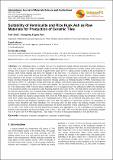| dc.contributor.author | Abeid, Said | |
| dc.contributor.author | Park, Seungyong | |
| dc.date.accessioned | 2024-02-28T09:12:13Z | |
| dc.date.available | 2024-02-28T09:12:13Z | |
| dc.date.issued | 2018-02-03 | |
| dc.identifier.uri | 10.11648/j.ijmsa.20180702.12 | |
| dc.identifier.uri | https://dspace.nm-aist.ac.tz/handle/20.500.12479/2473 | |
| dc.description | This research article was published in the International Journal of Materials Science and Applications, Volume 7, Issue 2, 2018 | en_US |
| dc.description.abstract | The challenging issues in ceramic tiles are low mechanical strength, thermal discomfort and high production costs. And in most efforts to improve strength, emphasis has been placed on minimization of quartz content in the ceramic tiles formula. This is due to β-α phase inversion of quartz which occurs at 573°C during cooling resulting to the development of stresses which initiate fracture and affects the strength of the final body. The objective of this work was to evaluate the possibility of using vermiculite and rice husk ash (RHA) in the composition of ceramic tile body. Initially, a typical ceramic body composed of the mixture of vermiculite and RHA batched with clay, feldspar, quartz and kaolin was prepared. Ceramic bodies were then obtained from this ceramic mixture by pressing samples at a forming pressure of 35MPa. These bodies were then fired at 1180°C in a laboratory furnace and finally the changes in the physical and mechanical properties caused by the introduction of vermiculite and RHA were tested and evaluated. The chemical composition of the raw samples was analyzed by X-ray fluorescence (XRF) while the phase composition was investigated using X-ray diffraction (XRD). The morphology of the powdered samples was studied by using Scanning electron microscopy (SEM). The bulk density and open porosity of the sintered ceramic bodies were evaluated using Archimedes ‘principle while the flexural rupture strength was determined by the three point bending test method. The major chemical compounds in vermiculite raw sample were SiO2, Al2O3 and Fe2O3 while RHA sample was found to contain mainly SiO2. From the XRD analysis, vermiculite sample had crystalline vermiculite while RHA sample had amorphous silica at low temperature below 900°C and crystallized (tridymite) above 900°C. The results from physical and mechanical properties tests show that with addition of vermiculite and RHA, the percentage of porosity, water absorption and linear shrinkage were increasing while the bulk density and bending strength of the fired ceramic bodies decreased. Among the studied compositions tile bodies made from a blend containing 20% wt. vermiculite and 5% wt. RHA were found to have the best properties for ceramic tiles applications. For this combination the percentage of porosity, water absorption and linear shrinkage were 12.08%, 7.60% and 3.29% while the bulk density and bending strength were 1.88 g/cm3 and 18.84 MPa respectively. These values were close to the required standards of wall and floor tiles. | en_US |
| dc.language.iso | en | en_US |
| dc.publisher | International Journal of Materials Science and Applications | en_US |
| dc.subject | Vermiculite | en_US |
| dc.subject | Tridymite | en_US |
| dc.subject | Amorphous | en_US |
| dc.subject | Crystalline | en_US |
| dc.subject | Flexural Strength | en_US |
| dc.title | Suitability of Vermiculite and Rice Husk Ash as Raw Materials for Production of Ceramic Tiles | en_US |
| dc.type | Article | en_US |

